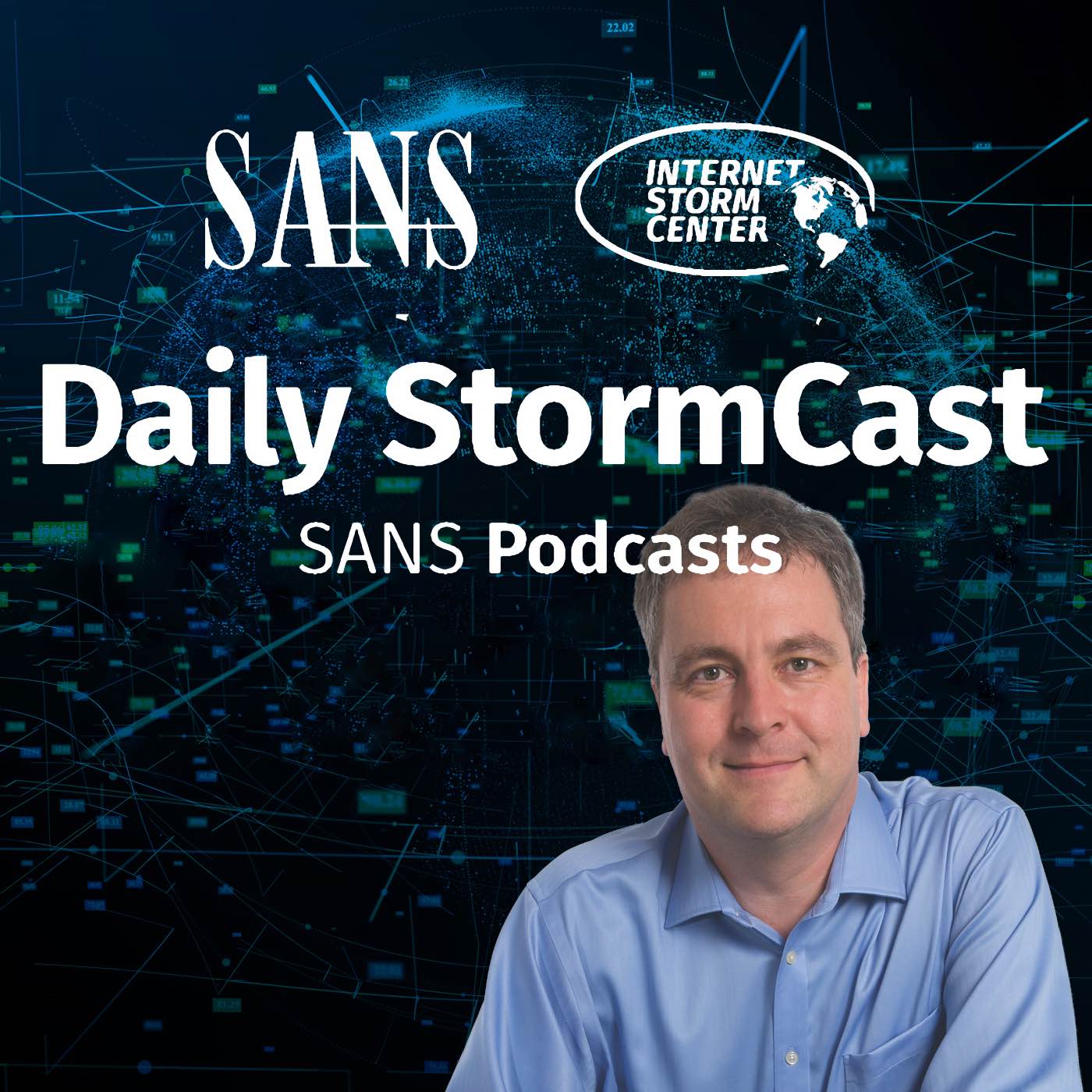Handler on Duty: Didier Stevens
Threat Level: green
Podcast Detail
SANS Stormcast Tuesday Apr 1st: Apache Camel Exploits; New Cert Authorities Requirements; Possible Oracle Breach
If you are not able to play the podcast using the player below: Use this direct link to the audio file: https://traffic.libsyn.com/securitypodcast/9388.mp3

Apache Camel Exploits; New Cert Authorities Requirements; Possible Oracle Breach
00:00
My Next Class
| Application Security: Securing Web Apps, APIs, and Microservices | Orlando | Mar 29th - Apr 3rd 2026 |
| Network Monitoring and Threat Detection In-Depth | Amsterdam | Apr 20th - Apr 25th 2026 |
Apache Camel Exploit Attempt by Vulnerability Scans
A recently patched vulnerability in Apache Camel has been integrated into some vulnerability scanners, like for example OpenVAS. We do see some exploit attempts in our honeypots, but they appear to be part of internal vulnerablity scans
https://isc.sans.edu/diary/Apache%20Camel%20Exploit%20Attempt%20by%20Vulnerability%20Scan%20%28CVE-2025-27636%2C%20CVE-2025-29891%29/31814
New Security Requirements for Certificate Authorities
Starting in July, certificate authorities need to verify domain ownership data from multiple viewpoints around the internet. They will also have to use linters to verify certificate requests.
https://security.googleblog.com/2025/03/new-security-requirements-adopted-by.html
Possible Oracle Breach
Oracle still denies being the victim of a data berach as leaked data may show different.
https://doublepulsar.com/oracle-attempt-to-hide-serious-cybersecurity-incident-from-customers-in-oracle-saas-service-9231c8daff4a
https://www.theregister.com/2025/03/30/infosec_news_in_brief/
https://www.darkreading.com/cyberattacks-data-breaches/oracle-still-denies-breach-researchers-persist
Discussion
New Discussions closed for all Podcasts older than two(2) weeks
Please send your comments to our Contact Form
| Application Security: Securing Web Apps, APIs, and Microservices | Orlando | Mar 29th - Apr 3rd 2026 |
| Network Monitoring and Threat Detection In-Depth | Amsterdam | Apr 20th - Apr 25th 2026 |
| Application Security: Securing Web Apps, APIs, and Microservices | San Diego | May 11th - May 16th 2026 |
| Network Monitoring and Threat Detection In-Depth | Online | Arabian Standard Time | Jun 20th - Jun 25th 2026 |
| Network Monitoring and Threat Detection In-Depth | Riyadh | Jun 20th - Jun 25th 2026 |
| Application Security: Securing Web Apps, APIs, and Microservices | Washington | Jul 13th - Jul 18th 2026 |
| Application Security: Securing Web Apps, APIs, and Microservices | Las Vegas | Sep 21st - Sep 26th 2026 |
Podcast Transcript
Hello and welcome to the Tuesday, April 1st, 2025 edition of the SANS Internet Storm Center's Stormcast. My name is Johannes Ullrich and today I'm recording from Jacksonville, Florida. Well, today I found some exploit attempts against a recent Apache Camel vulnerability. Camel is one of those data exchange frameworks. It's essentially used to make it easier in enterprise systems to shuffle data from one system to the other, receive the data, manipulate it, and so on. Recently, they published a fairly straightforward to exploit vulnerability. There are two headers in Camel that can be used to execute operating system commands. That's kind of the point of these headers, but they're access controlled and they're checking if these headers are present or not. The only problem is that when they're checking if the headers are present, they're looking for specific upper lower case patterns. Well, kind of Camel case. And when it's actually then being executed, the case doesn't matter. So it's pretty straightforward to bypass the filter by just using all lower case, all upper case, something like that. That's not then blocked by the initial check and the operating system commands will still be executed. At this point, I wouldn't really sort of call what we're seeing as exploited in the wild. It looks more like vulnerability scans. Even the one I have here really looked more like sort of an internal vulnerability scan that ended up in one of our other honeypots for some reason. Could of course be some internal lateral movement or something like this, but I doubt it is. They're using a standard vulnerability scanner here and don't really think that this is actual attack activity, but just shows it's extremely easy to exploit this vulnerability. In order to exploit the vulnerability, you need to run Apache Camel not in a standard configuration. And I'll refer to the Camel announcement for all the details here. The problem with this is that the CVSS score of the vulnerable is actually quite low. It's sort of in a medium range, like 4 or 5. The CVSS score is quite low. And that may cause you to overlook the vulnerability. The low CVSS score is based on, well, the vulnerability not being exploitable in the default configuration. But if you have a vulnerable configuration, it's trivial to exploit. And then we have an update on certificate requirements by the Certificate Authority Browser Forum. That's the industry group that sets the standards for certificate issuance. Nothing too crazy. They just had a vote and approved these proposals. They're going to be effective in July. Some of the crazier stuff like certificates valid only for six days and such. I don't see it here. There are really two main new things. One is a multi-perspective issuance corroboration. What it refers to is that the Certificate Authority needs to verify data that's being used to corroborate that this is your domain, like DNS lookups. They need to use various viewpoints from the internet. So they can't just do these lookups from one data center. And then also something that I'm surprised hasn't been there already. And that's linting, which refers to, well, making sure that the certificate is actually properly formed. And I don't see a specific linter being specified here. But I'll refer in the show notes to the little Google write up here, which I think summarizes it pretty well. So as far as the end user is concerned, that shouldn't really have any effects. Your Acme clients and such should just work as before. Just know when they are then verifying, for example, your secret file that you put like in your .well -known directory. Well, these requests should come from various data centers around the world, not just sort of one request. And then we had a couple of queries actually coming in about the Oracle breach, or I should say the suspected Oracle breach. There has been some suspicion that Oracle's cloud environment was breached to some point. The health part of Oracle's cloud actually admitted to a breach affecting that part of the cloud. But some group did also publish data that they claim came from other Oracle cloud customers. And some of the customers have validated that data. I can't really tell you which side is wrong, or you know, what exactly happened. I think that's still very much open to interpretation. The real question is, what should you do? And well, it comes back down to that cloud providers are part of your supply chain. So you need to establish some trust to these cloud providers. If you lose the cloud providers, then well, maybe they're not the provider that you should be using. But of course, that's sort of a more longer term discussion immediately. Well, really up to you. I can't really tell you how you perceive the risk, but changing credentials, changing passwords, API keys and such is certainly something to consider. And if you're using Oracle's cloud, definitely make sure that your data is not in that leaked data. There are a couple of sites that allow you to search that data. Another issue always to consider here is the data may not come from Oracle itself. It may come from one of their suppliers or maybe a completely different place. It just happens to be that, you know, people with some of these have that use similar passwords across different providers. So take a look at it if you're using Oracle's cloud. But at this point, I think it's very much open what exactly happened. I hope that Oracle will come up with either, hey, you know, we have been breached. This is what happened. Or well, we identified that this data is coming from somewhere else. Either way, it would be nice to have sort of a definite resolution with evidence and everything. for what exactly happened. Well, and this is it for today. Thanks for listening. Just a quick note, there will be no April Fool's jokes on the United Storm Center website. We don't really think that's something we want to get into. And be careful, of course, of other sites that may engage in that. Thanks and talk to you again tomorrow. Bye.










